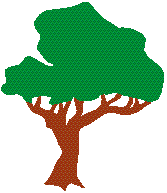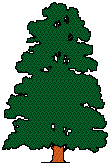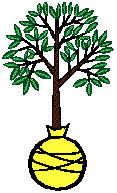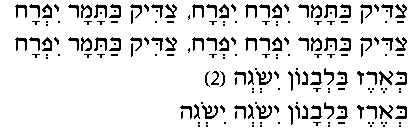
A BRIEF HISTORY OF TU B'SHEVAT
Tu B'shevat was first mentioned in the Mishnah, as one of four "New Year" days, the New Year of Trees. It was of great importance to the agricultural life of Israel, for it was the day when the tax in kind, a part of the crop paid to the Kohanim and the Levites, was calculated. It was a logical time for such tithing; since Tu B'Shevat falls between all the growing seasons, and the exact amount of the crop was already known, the exact assessment could be calculated. At this time, the severe rains of the winter in Israel begin to subside. The Jerusalem Talmud tells us that "Until now "(15th of Shevat) they (the trees) lived on the water of last year. From now on, they live on the water of the new year."
As signs of Spring begin to appear, the weather becomes milder and the fields begin to sprout green. A riot of flowers of every kind carpet the earth. The almond is the first of the trees to blossom, and the trees give forth a fresh and pleasant aroma.
The Israeli birds, which migrated to warmer climates during the rainy season, return home. The Jewish people in ancient Israel, most of whom were farmers, were aware of and sensitive to these changes in nature. Israel is a land of varied topography. While plants in the colder regions put forth leaves, those in warmer areas already have flowers. In earlier times, the inhabitants of the valleys celebrated the New Year of the Trees on the first day of Shevat, and those who lived in the hills celebrated it on the 15th. The two great rabbis, Hillel and Shamai, also had different opinions on the proper date, and ultimately Hillel's view was accepted, that the holiday should be on the 15th of Shevat.
At that time, Tu B'Shevat was not a festival or feast day. But people regarded the 15th of Shevat not only as an important date in their agricultural life, but as the day of judgement of the trees. As the fate of human beings is decided on Rosh Hashanah, so tradition tells us, the fate of the trees was to be decided on Rosh Hashanah Laillanot (the New Year's Day for Trees on the 15th of Shevat)…"Which shall suffer from adverse weather and harmful insects and which shall brave all dangers."
Tu B'Shevat gradually become a festival, and special prayers and liturgical poems about trees were recited. The earliest such poem known is by Yehuda Halevi Berabi Hillel (approximately 1000 CE) who wrote "Edar Nizley Yesha." Each verse mentions a different tree, in alphabetical order.
The tradition grew. The Jews continued to celebrate Tu B'Shevat over the centuries, adding to the prayers and poems the custom of eating fruits at a special holiday meal on this day.
Then, with the conquering of Israel by Crusaders in the 11th century, and the dispersion of the Jews, the tradition of celebrating Tu B'Shevat almost disappeared. Almost, but not quite - though many people in the Diaspora did not know the reason for it, they continued to observe the holiday by eating fruit. In some areas, children were given a holiday from school, and the day was celebrated as a festival.
It was the Kabbalists settling in Safed 400 years ago who revived the holiday of Tu B'Shevat. They established a special "Seder for Tu B'Shevat," similar in structure to the Pesach seder. Four cups of wines, the first one white, the second slightly darker, the third darker still, and the fourth a red wine, were drunk. Interwoven with this was a special order of eating fruits. Each group of fruits had a special meaning, and while they were eaten, prayers, poems and verses recited. So, Tu B'Shevat, the Festival of the New Year of Trees, was revived and restored by the Kabbalists.
The history of the holiday doesn't stop there. With the rise of the Zionist movement at the end of the last century came a renewed emphasis on planting the land. The festival of Tu B'Shevat gained importance in Israel and became specifically associated with tree planting. This custom seems to have been started by the settlers of Yesud Ha'Ma'la, in the Galil, who planted 1500 trees on Tu B'Shevat, 1884. Others in Israel demonstrated their enthusiasm by continuing this custom: the first avenue of trees in Tel Aviv was planted on Tu B'Shevat, 1910, by school children from Jaffa. The holiday has become inseparably linked with the Jewish National Fund: the forests planted by the Jewish National Fund are familiar and significant signs of the growth of Israel.
The holiday continues to evolve, and new meaning is found in old customs and traditions. In Israel, the day has been designated as the "Nature Festival," and Israel's Nature Protection Society organizes educational programs and excursions to nature reserves. Other creative and enjoyable ways of celebrating Tu B'Shevat are being developed. The focal point of these celebrations is the interrelationship between the trees of Israel, the land of Israel, and the people of Israel.
(American Zionist Youth Foundation in Cooperation with NEOT KEDUMIM, THE GARDENS OF ISRAEL)
Tu B'Shevat Seder
all rights reserved
Please note: This seder service is copyrighted. You may copy it for use by your family. If you wish to use it for a synagogue, chavurah, or other use, you must obtain my permission.
For pdf version of seder (easier to print out) click here. (The pages will appear in reverse order, but it will print out just fine.)
For explanation of seder, click here.
For preparation instructions (foods and supplies you'll need, how to organize it, etc.) click here.
We have joined together to celebrate the New Year of the Trees. Tu B'Shevat has long been a Jewish tradition, for Jews have always honored trees and appreciated the food, shade and shelter they provide. The custom of holding a Tu B'Shevat seder dates back to the Kabbalists who lived in Israel in the 16th century. Like them, we have gathered together to eat, sing, and rejoice in the miracle of the tree.

BA-RUCH A-TA A-DO-NAI E-LO-HAY-NU ME-LECH HA-O-LAM SHE-HE-CHE-YA-NU VE-KI-YE-MA-NU VE-HI-GI-YA-NU LAZ-MAN HA-ZEH.
Blessed are You, O Lord our God, ruler of the universe, who has kept us alive and sustained us and allowed us to reach this joyous occasion.
Four Questions for Tu B'Shevat
- Other new year celebrations honor people or events. Why do we have this special New Year to honor trees?
- On other days we eat all kinds of fruits. Why, on Tu B'Shevat, do we especially eat fruits from Eretz Yisrael, the Land of Israel?
- Here, and in much of the world, it is still winter. Why do we talk about trees and planting now?
- Since trees make their own seeds to reproduce, why do we celebrate trees by planting new seeds?
The First Cup: Apple Juice
 With our first cup of juice, we honor the apple tree which grows here in our own community. It reminds us of all our community offers us and of the importance of celebrating and learning with the Jews around us. Jews live in small communities throughout the world, taking care of one another and celebrating together.
With our first cup of juice, we honor the apple tree which grows here in our own community. It reminds us of all our community offers us and of the importance of celebrating and learning with the Jews around us. Jews live in small communities throughout the world, taking care of one another and celebrating together.
Long ago, there lived a righteous man named Honi. One day he saw an old man planting a carob tree. Honi said to him: "Foolish man, do you think you will live to eat and enjoy the fruit of the tree you plant today? It will not bear fruit for many, many years."
The old man replied: "I found trees in the world when I was born. My grandparents planted them for me. Now I am planting for my grandchildren."
Honi sat down in the shade of a nearby tree to take a short nap. But his short nap lasted 70 years! When he awoke, he was surprised to see a full-grown carob tree where the old man had planted a seed just before Honi fell asleep. An elderly man was picking its fruit. "Are you the man who planted this tree?" asked Honi.
"No," replied the man. "My grandfather planted it for me." And so Honi learned the importance of planting seeds for future generations. Our Torah is called Aytz Chaim, the Tree of Life. Jews in every community plant seeds for future generations by passing on traditions and learning from parents to children, as we do here today.
Together we share and enjoy the sweetness of fruits which grow in our community and in communities throughout our country: apples, walnuts, raisins. May each Jewish community, like trees, nourish and shelter its members.
BA-RUCH A-TAH A-DO-NAI, E-LO-HAY-NU ME-LECH HA-O-LAM, BO-RAY P-RI HA-AYTZ.
Blessed are You, O Lord our God, ruler of the universe, who creates the fruit of the trees.
With thanks that we are here celebrating Tu B'Shevat together, we sing:
How good and how pleasant it is when brethren live together!
HI-NAY MA TOV U-MA NA-YIM SHE-VET A-CHIM GAM YA-CHAD.
The Second Cup: Orange Juice

The Land of Israel is the birthplace of the Jewish people. More than 3000 years ago, God made a covenant with Abraham, promising to make him a great nation and to give his descendants Eretz Yisrael. The Land of Israel has been important to Jews ever since.
For many years there was a Jewish nation in the Land of Israel. Then for nearly 2000 years, although Jews lived there, others ruled the Land. Today, there is once again a Jewish nation in the Land of Israel, called the State of Israel. Her people are our people. We are brothers and sisters.
On Tu B'Shevat we remember the Eucalyptus tree with which the early Jewish pioneers of the Land of Israel &emdash; called chalutzim &emdash; drained the swamps 100 years ago. The Eucalyptus can absorb tremendous amounts of water and the chalutzim were able to reclaim many dunams of land by planting them.
The early chalutzim sang this song while they planted:
We have come up to the Land,
we have tilled the soil and sown the seeds,
but we have yet to harvest our crop.
AR-TZA A-LI-NU, AR-TZA A-LI-NU, AR-TZA A-LI-NU (2)
K'VAR CHA-RASH-NU V'GAM ZA-RA-NU (2)
A-VAL OD LO KA-TZAR-NU (2)
As we share the fruits of the Land of Israel and drink the juice of the oranges grown on land which used to be swamps, let us recall our bond with the people of the State of Israel:
BA-RUCH A-TAH A-DO-NAI, E-LO-HAY-NU ME-LECH HA-O-LAM, BO-RAY P-RI HA-AYTZ.
Blessed are You, O Lord our God, ruler of the universe, who creates the fruit of the trees.
The Third Cup: Pineapple Juice

Our third juice and our third plate of fruits come from around the world: bananas, coconuts, olives, apricots, pineapples. We will share some of them together today. They remind us of our obligation to Jews around the globe. We are our brothers' keepers.
Oil pressed from olives was used to keep the Ner Tamid (the Eternal Lamp) lit in the Temple in Jerusalem. It symbolizes the light of Jewish life, kept alive in small communities throughout the world.
Together let us enjoy some of these fruits from around the world:
BA-RUCH A-TAH A-DO-NAI, E-LO-HAY-NU ME-LECH HA-O-LAM, BO-RAY P-RI HA-AYTZ.
Blessed are You, O Lord our God, ruler of the universe, who creates the fruit of the trees.
It is a Jewish tradition for Jews around the world to send money to Israel on Tu B'Shevat to plant trees and help rebuild the Land. We will pass around a tzedakah box now and combine all our contributions to plant as many trees as we can.
The Fourth Cup: Fruit of the Vine

Our people has always dreamed of a day when hatred and war will be forgotten; a day when no one will go hungry and no one will suffer homelessness; a day when we will all care for one another and live together in peace. Our sages called it the Messianic Age.
Rabbi Yochanan ben Zakkai taught that as important as the messianic age is, if you are planting a tree when someone tells you that the Messiah has arrived, you should finish your planting, and then go to greet the Messiah. Trees provide food and homes and warmth and shade. They contribute to the building of the Messianic Age.
We contribute to making the world a better place when we become the best people we can be. A tzaddik, a righteous person, is often compared with the erez, the cedar tree, which grows tall, strong and proud. The cedar tree was used to panel the outside of the Temple in Jerusalem, a building dedicated to God's compassion and people's righteousness.
There is a song from the Bible which compares the righteous person to a cedar tree. Let us sing it together:
The righteous shall flourish like a date palm;
the righteous shall grow as tall as a cedar in Lebanon.
(Psalm 92)

TZA-DIK KA-TA-MAR YI-F'RACH YI-F'RACH )2
TZA-DIK KA-TA-MAR YI-F'RACH )
K'E-REZ BA-L'VA-NON YIS-GEH (2)
K'E-REZ BA-L'VA-NON YIS-GEH YIS-GEH.
R. Elazar ben Azaryah said: One whose wisdom exceeds his good deeds is like a tree with many branches but few roots: the wind comes and plucks it up and overturns it. But one whose good deeds exceed his wisdom is like a tree with few branches but many roots: even if all the winds in the world come and blow upon it, it cannot be uprooted. May our learning lead to good deeds which improve our world.
Instead of eating fruit this time, we will plant seeds for the future, as Honi did. We will plant parsley seeds in the hopes that we will enjoy our harvest this Pesach. On Passover, we recall how God saved our ancestors from slavery in Egypt. Then we open the door for Elijah the prophet who, according to tradition, will herald the redemption of the whole world: the Messianic Age.
Wine is our symbol of joy. We rejoice in the goodness of the earth and in the fruit of the trees. We rejoice in our families and those with whom we share this Tu B'Shevat seder. We rejoice in the accomplishments and promise of the State of Israel. We rejoice in the dream of world peace. And we rejoice especially in the dream of the Messianic Age and pray that it will soon become a reality.
BA-RUCH A-TAH A-DO-NAI, E-LO-HAY-NU ME-LECH HA-O-LAM, BO-RAY P-RI HA-GA-FEN.
Blessed are You, O Lord our God, ruler of the universe, who creates the fruit of the vine.
In every seed there is the promise of new life. May we, in our lives, plant seeds of wisdom, friendship and peace.
![]()
LE-SHA-NA TO-VA U-VE-RA-CHA P'RI U-TE-NU-VA.
May the year be fruitful and blessed!
Preparation for the Seder
It works best to hold the seder in a room with tables, such that everyone can sit at a table with a plate, cup, and napkin in front of them and a copy of the seder service in their laps. It will work well to arrange people sitting at a number of small tables clustered together. Prior to the seder, prepare 3 pitchers of juice (for the first three cups), a bottle of wine, and one of sparkling grape juice for those who do not drink alcohol, and 3 plates of fruits to accompany each cup of juice. The plates of fruit should contain small pieces of several of each fruit listed below, so that each participant can take a taste of each fruit offered. I recommend passing out juice and fruit at the beginning of each section of the seder, so that the flow of the liturgy is not interrupted.
First Cup: apple juice
First Plate of Fruits: apple, walnut, raisin
Second Cup: orange juice
Second Plate of Fruits: fig, date, peach, mango, pomegranate, almond, orange (chose several from among the list)
Third Cup: pineapple juice
Third Plate of Fruits: coconut, olive, apricot, pineapple, banana
Fourth Cup: Shabbat wine
Fourth Plate: In place of fruits, we pass around cups of dirt and parsley seeds and everyone plants parsley for use at their Pesach seder. Then we pass around a tzedakah container and use the money to plant trees in Israel.
Explanation of the Seder
The seder is structured in a similar fashion to the Passover seder, beginning with Shehecheyanu, and launched by Four Questions. The structure hinges on Four Cups, which introduce the themes of Jewish community and identity: the local community, the Jewish community in Eretz Yisrael, the global Jewish community, and the messianic dream. Each cup is accompanied by fruits which exemplify these themes.










 By David Brickner
By David Brickner  Of all the Jewish communities in the world, Tu B'shevat is by far most widely celebrated in Israel, where planting trees has been extremely important in the process of reclaiming and revitalizing that once arid and barren land. The Jewish National Fund has taken on much of the responsibility of reforestation in Israel. Many tourist groups, Jewish and Christian alike, take the opportunity to help in that process by purchasing trees to plant in Israel's forests. The last time I was in Israel, I had the privilege of planting trees in honor of Moishe and Ceil Rosen. The devastating fire in the Mount Carmel region lately probably lends even more importance to Tu B'shevat this month.
Of all the Jewish communities in the world, Tu B'shevat is by far most widely celebrated in Israel, where planting trees has been extremely important in the process of reclaiming and revitalizing that once arid and barren land. The Jewish National Fund has taken on much of the responsibility of reforestation in Israel. Many tourist groups, Jewish and Christian alike, take the opportunity to help in that process by purchasing trees to plant in Israel's forests. The last time I was in Israel, I had the privilege of planting trees in honor of Moishe and Ceil Rosen. The devastating fire in the Mount Carmel region lately probably lends even more importance to Tu B'shevat this month.























